
Gregory of Nazianzus, also known as Gregory the Theologian or Gregory Nazianzen, was a 4th-century Archbishop of Constantinople, and theologian. He is widely considered the most accomplished rhetorical stylist of the patristic age. As a classically trained orator and philosopher he infused Hellenism into the early church, establishing the paradigm of Byzantine theologians and church officials. Gregory of Nazianzus was the patron saint of medieval Bosnia before the Catholic conquest when he was replaced by Gregory the Great.

Martin of Tours was the third bishop of Tours. He has become one of the most familiar and recognizable Christian saints in France, heralded as the patron saint of the French Third Republic, and is patron saint of many communities and organizations across Europe. A native of Pannonia, he converted to Christianity at a young age. He served in the Roman cavalry in Gaul, but left military service at some point prior to 361, when he became a disciple of Hilary of Poitiers, establishing the monastery at Ligugé. He was consecrated as Bishop of Caesarodunum (Tours) in 371. As bishop, he was active in the suppression of the remnants of Gallo-Roman religion, but he opposed the violent persecution of the Priscillianist sect of ascetics.

Pope Gregory I, commonly known as Saint Gregory the Great, was the bishop of Rome from 3 September 590 to his death. He is known for instigating the first recorded large-scale mission from Rome, the Gregorian Mission, to convert the then-pagan Anglo-Saxons in England to Christianity. Gregory is also well known for his writings, which were more prolific than those of any of his predecessors as pope. The epithet Saint Gregory the Dialogist has been attached to him in Eastern Christianity because of his Dialogues. English translations of Eastern texts sometimes list him as Gregory "Dialogos", or the Anglo-Latinate equivalent "Dialogus".

Gregory of Nyssa, also known as Gregory Nyssen, was bishop of Nyssa from 372 to 376 and from 378 until his death. He is venerated as a saint in Roman Catholicism, Eastern Orthodoxy, Oriental Orthodoxy, Anglicanism, and Lutheranism. Gregory, his elder brother Basil of Caesarea, and their friend Gregory of Nazianzus are collectively known as the Cappadocian Fathers.

Todi is a town and comune (municipality) of the province of Perugia in central Italy. It is perched on a tall two-crested hill overlooking the east bank of the river Tiber, commanding distant views in every direction.

Saint Martial, called "the Apostle of the Gauls" or "the Apostle of Aquitaine", was the first bishop of Limoges. His feast day is June 30.

Venantius Honorius Clementianus Fortunatus was a Latin poet and hymnographer in the Merovingian Court, and a Bishop of the Early Church. He has been venerated as Saint Venantius Fortunatus since the Middle Ages.
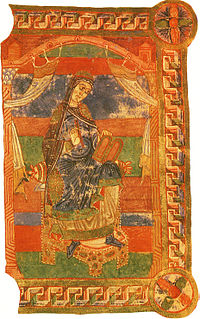
Radegund was a Thuringian princess and Frankish queen, who founded the Abbey of the Holy Cross at Poitiers. She is the patron saint of several churches in France and England and of Jesus College, Cambridge.
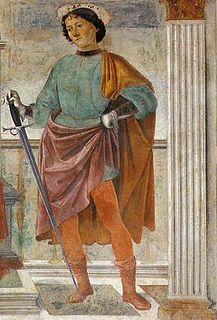
Julian the Hospitaller is a Roman Catholic saint.
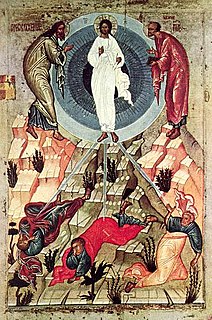
Fra Jacopone da Todi, O.F.M. was an Italian Franciscan friar from Umbria in the 13th century. He wrote several laude in the local vernacular. He was an early pioneer in Italian theatre, being one of the earliest scholars who dramatised Gospel subjects.

Saint Nicetius was a bishop of Trier, born in the latter part of the fifth century, exact date unknown; died in 563 or more probably 566.

Saint Albinus of Angers was a French abbot and bishop. Born to a noble Gallo-Roman family at Vannes, Brittany, St. Albinus was a monk and from 504 C.E. Abbot of Tintillac. His reputation spread during the twenty-five years in which he served as abbot. In 529, St. Albinus was elected, against his wishes, Bishop of Angers.
Saint Abundius the Sacristan was a sacristan of the Church of Saint Peter in Rome.

Simon Rinalducci of Todi was a famous Italian Augustinian friar and preacher of the 13th century.
Francis Gladden Bishop was a minor leader in the Latter Day Saint movement after the 1844 succession crisis. Bishop claimed to be the rightful successor to Joseph Smith; from the 1850s until his death, Bishop led a succession of small groups of Latter Day Saints and converts. His followings have been identified informally by later writers as the Gladdenites and the Church of Jesus Christ of Latter Day Saints (Gladdenite), though the name of a late following is formally The Church of Jesus Christ of the New Jerusalem. In the 1850s, many of Bishop's followers abandoned him and joined the movement that would later become the Church of Christ.
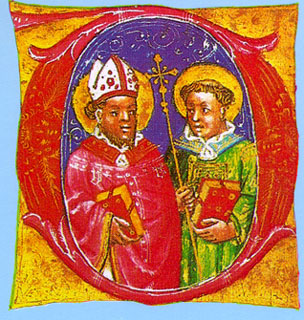
Saint Hermagoras of Aquileia is considered the first bishop of Aquileia, northern Italy. Christian tradition states that he was chosen by Saint Mark to serve as the leader of the nascent Christian community in Aquileia, and that he was consecrated bishop by Saint Peter. Hermagoras and his deacon Fortunatus evangelized the area but were eventually arrested by Sebastius, a representative of Nero. They were tortured and beheaded.

Saint Fortunatus of Spoleto was a parish priest near Spoleto in Umbria sometime between the 4th and 5th centuries. He is venerated as a saint within the Catholic Church.
Saint Fortunatus of Casei is venerated as a saint by the Catholic Church. Tradition makes him a member of the Theban Legion, and thus martyred at Agaunum. However, his relics were situated in the catacombs of Saint Callixtus in Rome until 1746, when Cardinal Guadagni, Roman vicar to Benedict XIV, re-exhumed and displayed Fortunatus’ relics in the collegiate church of Santa Maria in Via Lata in Rome. It is unclear how the relics of Fortunatus reached Rome from the saint's supposed place of death in the Swiss Alps.

October 13 - Eastern Orthodox liturgical calendar - October 15
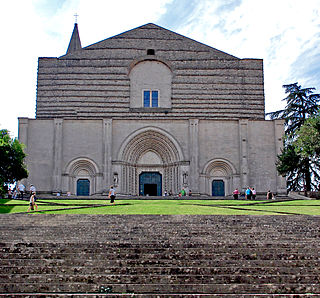
San Fortunato is a Gothic- and Renaissance-style, Roman Catholic church in the center of Todi, province of Perugia, region of Umbria, Italy.


















